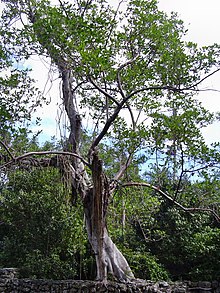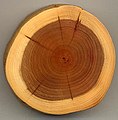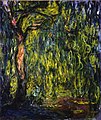The Trees Portal
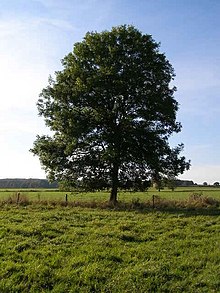
In botany, a tree is a perennial plant with an elongated stem, or trunk, usually supporting branches and leaves. In some usages, the definition of a tree may be narrower, including only woody plants with secondary growth, plants that are usable as lumber or plants above a specified height. In wider definitions, the taller palms, tree ferns, bananas, and bamboos are also trees.
Trees are not a monophyletic taxonomic group but consist of a wide variety of plant species that have independently evolved a trunk and branches as a way to tower above other plants to compete for sunlight. The majority of tree species are angiosperms or hardwoods; of the rest, many are gymnosperms or softwoods. Trees tend to be long-lived, some reaching several thousand years old. Trees have been in existence for 370 million years. It is estimated that there are around three trillion mature trees in the world.
A tree typically has many secondary branches supported clear of the ground by the trunk, which typically contains woody tissue for strength, and vascular tissue to carry materials from one part of the tree to another. For most trees it is surrounded by a layer of bark which serves as a protective barrier. Below the ground, the roots branch and spread out widely; they serve to anchor the tree and extract moisture and nutrients from the soil. Above ground, the branches divide into smaller branches and shoots. The shoots typically bear leaves, which capture light energy and convert it into sugars by photosynthesis, providing the food for the tree's growth and development.
Trees usually reproduce using seeds. Flowers and fruit may be present, but some trees, such as conifers, instead have pollen cones and seed cones. Palms, bananas, and bamboos also produce seeds, but tree ferns produce spores instead.
Trees play a significant role in reducing erosion and moderating the climate. They remove carbon dioxide from the atmosphere and store large quantities of carbon in their tissues. Trees and forests provide a habitat for many species of animals and plants. Tropical rainforests are among the most biodiverse habitats in the world. Trees provide shade and shelter, timber for construction, fuel for cooking and heating, and fruit for food as well as having many other uses. In much of the world, forests are shrinking as trees are cleared to increase the amount of land available for agriculture. Because of their longevity and usefulness, trees have always been revered, with sacred groves in various cultures, and they play a role in many of the world's mythologies. (Full article...)
Ficus aurea, commonly known as the Florida strangler fig (or simply strangler fig), golden fig, or higuerón, is a tree in the family Moraceae that is native to the U.S. state of Florida, the northern and western Caribbean, southern Mexico and Central America south to Panama. The specific epithet aurea was applied by English botanist Thomas Nuttall who described the species in 1846.
Ficus aurea is a strangler fig. In figs of this group, seed germination usually takes place in the canopy of a host tree with the seedling living as an epiphyte until its roots establish contact with the ground. After that, it enlarges and strangles its host, eventually becoming a free-standing tree in its own right. Individuals may reach 30 m (100 ft) in height. Like all figs, it has an obligate mutualism with fig wasps: figs are only pollinated by fig wasps, and fig wasps can only reproduce in fig flowers. The tree provides habitat, food and shelter for a host of tropical lifeforms including epiphytes in cloud forests and birds, mammals, reptiles and invertebrates. F. aurea is used in traditional medicine, for live fencing, as an ornamental and as a bonsai. (Full article...)Did you know? -
- ... that President Bill Clinton said he would personally pay the bill to keep the National Christmas Tree (pictured) lit during the government shutdown resulting from disagreements on the 1996 federal budget?
- ... that global precedence is the tendency to see the forest, and not the trees?
- ... that the mistletoe species Amyema congener of eastern Australia can grow on non-native peach, plum and pear trees?
- ... that foliage from the Australian rainforest tree Grevillea baileyana was used in the floral arrangements handed to medal winners at the 2000 Summer Olympics in Sydney?
- ... that most of the habitat of the vulnerable tree Eucalyptus benthamii has disappeared under Warragamba Dam or been cleared?
- ... that the inspiration for the Paustian House in Copenhagen came to architect Jørn Utzon while he was walking through a forest of beech trees?
- ... that Washington was the second largest tree of its kind until its collapse in 2005?
Selected article -
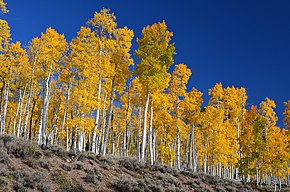
This is a list of the oldest-known trees, as reported in reliable sources. Definitions of what constitutes an individual tree vary. In addition, tree ages are derived from a variety of sources, including documented "tree-ring" (dendrochronological) count core samples, and from estimates. For these reasons, this article presents three lists of "oldest trees," each using varying criteria.
There are three tables of trees, which are listed by age and species. The first table includes trees for which a minimum age has been directly determined, either through counting or cross-referencing tree rings or through radiocarbon dating. Many of these trees may be even older than their listed ages, but the oldest wood in the tree has rotted away. For some old trees, so much of the center is missing that their age cannot be directly determined. Instead, estimates are made based on the tree's size and presumed growth rate. The second table includes trees with these estimated ages. The last table lists clonal colonies in which no individual tree trunks may be remarkably old but in which the organism as a whole is thought to be very old. (Full article...)General images
Selected lists
Subcategories
Related portals
Associated Wikimedia
The following Wikimedia Foundation sister projects provide more on this subject:
-
Commons
Free media repository -
Wikibooks
Free textbooks and manuals -
Wikidata
Free knowledge base -
Wikinews
Free-content news -
Wikiquote
Collection of quotations -
Wikisource
Free-content library -
Wikispecies
Directory of species -
Wikiversity
Free learning tools -
Wiktionary
Dictionary and thesaurus

